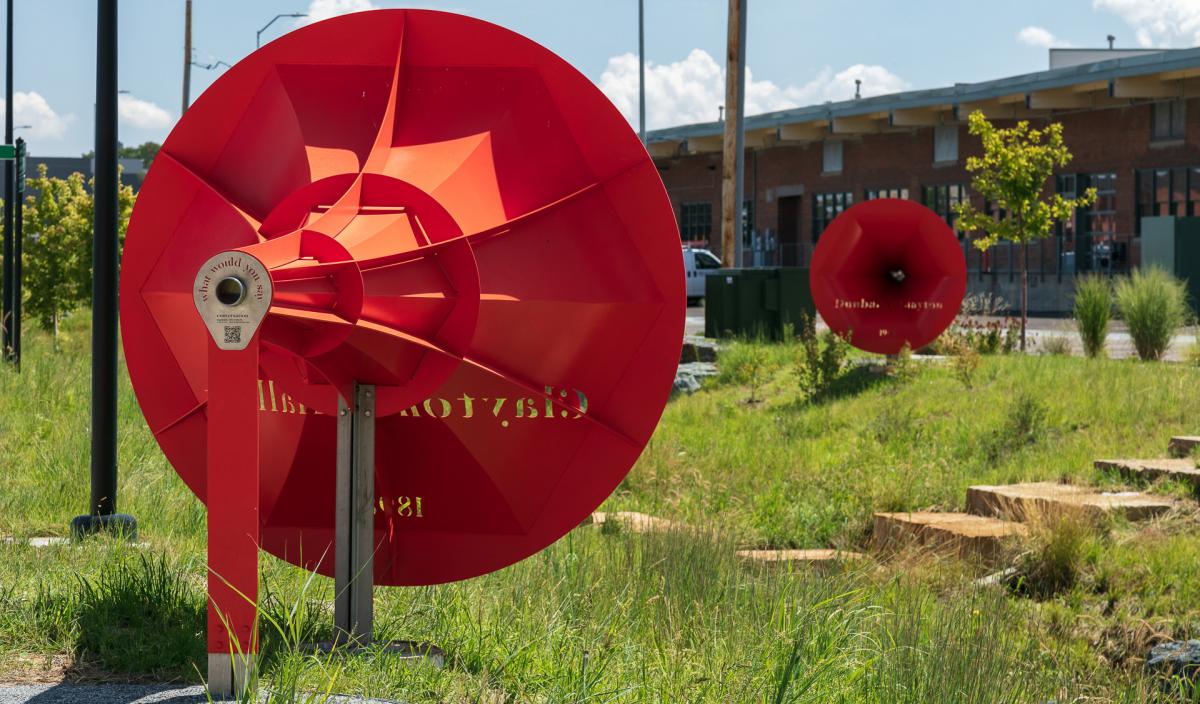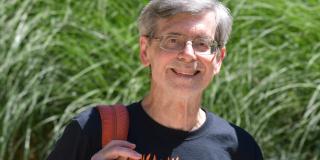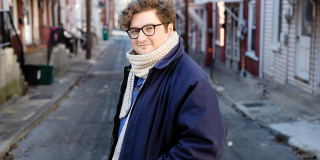
A mile-long park in Denver, Colo., has become a place where the past meets the present, reflected in four public art installations created by artist Wes Heiss. Filtered through the creative vision of Heiss, associate professor of product design in the Department of Art, Architecture and Design, the installations are helping to redefine the area in its new incarnation as a green space.
The installations reflect what the area has meant to current and past residents of the Clayton and Cole neighborhoods, where the park is located. All of the pieces provide opportunities for observers to interact with them. Each is distinctive but all four feature a red-orange color that subtly unifies them. Heiss explains that they also share the common function of marking something in the site – a direction, a piece of history, or a personal connection. The project is a departure from the industrial design classes Heiss teaches. Although it leverages some of the same skills, “it’s really art,” he says.
It is Heiss’s third commissioned work for the City of Denver. The first was the 14th Street Overlay, an interactive series marking the history of a 12-block corridor in the city. Heiss and his creative collaborator, Marek Walczak, were awarded the new commission to create public art for the park in 2018. After some delays imposed by the COVID-19 pandemic, the works are being installed in spring 2022. Inspiration for the pieces came from a variety of sources, from historical research to direct input from community members.
“We like to work with communities where they are helping produce the content and contributing some element to the design in a significant way,” Heiss explains. “That’s a really crucial part of our collaborative practice. We’re trying to make something that actually does speak to the place in a meaningful way.”
 The first of the four new installations -- a whimsical 16-foot-tall wayfinding sign with 37 different directional arrows – included a collaboration with the Bruce Randolph School in the Cole neighborhood. Heiss visited the public school, which includes sixth through twelfth grades, to kick off the project. An assignment in art classes challenged students to design arrows pointing to something that they care about.
The first of the four new installations -- a whimsical 16-foot-tall wayfinding sign with 37 different directional arrows – included a collaboration with the Bruce Randolph School in the Cole neighborhood. Heiss visited the public school, which includes sixth through twelfth grades, to kick off the project. An assignment in art classes challenged students to design arrows pointing to something that they care about.
The arrows selected for the installation point to diverse locations, near and far: downtown Denver, local playing fields, Germany, and the location of the Sand Creek Massacre, some 252 miles away, an historic event marking the killing of Cheyenne and Arapaho peoples. Some arrows reflect local lore: One points to Daddy Bruce Barb B Que Ribs, a nod to Daddy Bruce Randolph, the man for whom the school is named.
To transform the students’ designs into metal, drawings were scanned into a CAD program and traced. Allentown-based DiBello Metal Designs created stainless steel arrows that were powder coated in orange. All 37 are mounted on a single pole – a carefully engineered process allowing each to be visible amid the cluster. “It makes this kind of prickly looking, confusing, jumbled wayfinding sign,” Heiss explains. “The piece is really not about letting it be pointedly about a location that somebody knows, but about a kind of personal connection to a place.”
Other pieces in the installation capture the area’s history. Although it is a park, the space has a practical use for water retention, filling at the time of a flood. A water tower sculpture captures Denver’s flood history and its impact on the neighborhoods. Standing about nine feet above the ground, the tower is made of perforated metal. Light shining through it falls on a map marked with stained glass showing where a major flood happened in Denver in 1965 and the projected area for a 100-year-flood that is yet to happen. “We wanted to do a piece that had a direct connection to the actual function of the site,” Heiss says. “It’s a playful way of reminding everyone why they’re there.”
A third piece in the series is a nod toward another time in the location’s history. Heiss says that he and his collaborator did extensive research and conducted a site visit before submitting their proposal to the city. They learned that the site once had a rail line running through it. “One of the things that popped up was the Burlington Zephyr, which was arguably the first successful streamliner train,” Heiss says. “It set a speed record in 1934, running from Chicago to Denver, and it went right through the site on the rail lines that were extracted and removed from the site for this project to be done. We thought it would be great to bring the train back to this unassuming but historic place.”
Heiss created a swooping metal image that looks like the profile of the train coming around the bend, capturing the way it moved through space. In creating it, Heiss says, “We think about time and speed and your place in that relationship. The object is actually a sundial.” The train sculpture juts over the sidewalk, which has lines marking where it casts its shadow at different times of day.

The remaining piece in the quartet invites observers to examine and interact with it. “Conversation” consists of two 8-foot-long metal horns. Positioned to face each other across a ravine, the two structures function as megaphones, allowing people positioned at each to speak to one another, even at a whisper, across the space. An engineer in Germany helped to create horns that could properly amplify the human voice. Although playful, the piece also is an homage to serious conversations now being held about race. Carved into the front of each horn is the name and date of two landmark Denver court cases – Clayton v. Hallett (1898) and Dunbar v. Clayton (1969). The first case outlined parameters for establishing Clayton College, specifying it as a school for white, orphaned boys. The second case successfully challenged the discriminatory practices used in founding the institution.
Both court cases mentioned in “Conversation” relate to George Washington Clayton, who founded Clayton College and for whom the neighborhood is named. A plan to re-name the Clayton neighborhood led the city to put on hold plans for a fifth work originally commissioned for the project. Heiss’s design for that installation created three cylinders leveraging anamorphic design – an intentional distortion of words or an image that becomes clear when viewed from the correct angle. (“It’s like when you see the yield sign painted on the street with stretched out letters that appear normal when you move closer,” Heiss says.) Upon closer inspection, visitors would see the names of the Cole, Clayton and Elyria-Swansea neighborhoods surrounding the park.
Heiss emphasizes that the installation, while fun, also engages the viewer with serious issues like racism or events like 100-year floods. “It's good to be surprised. It's good to be caught off guard in a positive way,” Heiss says. “I hope that these pieces respect this interesting site and open up a space for conversation.”
Images by Wes Magyar






